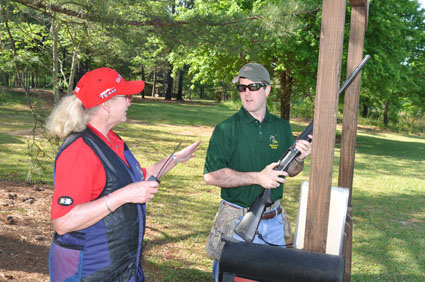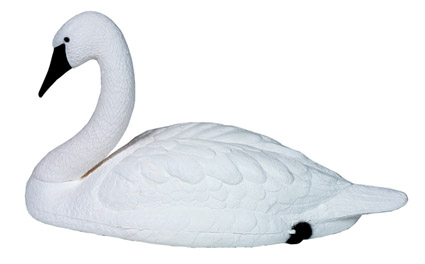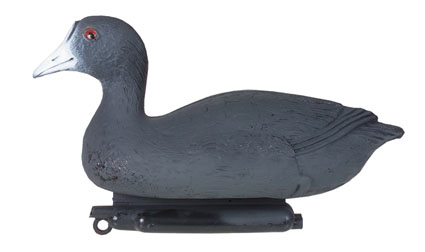 Lessons from a local professional shooter can take you from an average wingshooter to one that doesn't seem to miss. |
1. Sleeping on the ice — With ice or snow on the ground, geese often land and immediately lay down; their body heat melts the hard cover, exposing the food beneath. With the food source uncovered, they’ll feed, sleep, and loaf — all without rising. Sleeper or no leg decoys are very realistic under such conditions, and almost impossible for birds to ignore.
2. Take a shooting lesson from a skilled instructor — We all shoot well enough, right? The truth is, most shotgunners — myself certainly included — could benefit from four to eight hours spent under the watchful eye of a trained shooting instructor. Lessons from the likes of Gil and Vicki Ash (www.ospschool.com) will take up where patterning and experimentation leave off.
3. Concealment isn’t a game — There’s nothing wrong with being Type A about camouflage and concealment; hiding and becoming invisible is what it’s all about. Cut enough brush for your blinds to last all season, and stack what you don’t use some distance away. It will age with time, and will match the native vegetation perfectly when it’s time to touch-up.
4. Think small and out-of-the-way places — Is there a tiny, out-of-the-way corner of that pressured public wetland that doesn’t get much human attention? Detailed maps or websites such as teraserver.com or maps.google.com can reveal the location of virtually untouched hunting hotspots — and if you’re willing to walk and pack a small spread, you might be surprised.
5. The art of realism and natural movement — With today’s decoys and birds as they are, modern spreads are all about realism and natural movement. Once you set your rig, step back and evaluate it. Does it look real? Does it move as it should? If it doesn’t look natural to you, why should it look good to the ultimate judge backwinging overhead?
 Placing a unique decoy alongside the others in your spread might be the ticket to having the perfect spread for those decoy-shy waterfowl. |
6. Unique species in decoy spreads — Everyone runs Canadas for Canadas, and mallards for all ducks; why not give the birds something they haven’t seen? Try six snows — the white really draws attention! — off to one side of your Canada spread. Or six drake sprig, widgeon, or gadwall in your mallard rig. Maybe an all-widgeon spread? Often, different can be good.
7. Go back to school — Today’s duck and goose gurus are some of the best in history. And what’s more, they’re accessible to us, the common guys. Thanks to the Internet, outdoor educators like Fred Zink, Field Hudnall and Tim Grounds are right at our fingertips. So go ahead. Ask questions. Read the forums. Study the DVDs. And practice.
8. Study, study, study — what makes real birds real — Pros like Allan Stanley or Scott Threinen are good at what they do because they never stop studying their subjects; in these boys’ case, geese. Watching and listening to birds year-round can greatly increase your knowledge base when it comes time to set the decoys and blinds.
9. Pay strict attention to detail — I’ll make this one easy: There is no such thing as an insignificant detail when it comes to hiding from or attracting via decoy ducks and geese. Sure, sloppy hunters kill some birds. But sloppy hunters aren’t consistent hunters, and consistency means paying attention to all the details. Make it look good, and keep it looking good.
10. Create on-the-water motion — Spinning-wing decoys and other gadgetry might be all the rage now, but it’s hard to beat a good old-fashioned jerk cord for creating the illusion of motion and attracting ducks. Use a lightweight water-keel decoy; they bounce better and send out more ripples. And when in doubt — drop the call and pull the string.
 Coot decoys are very effective in bring pressured birds into your spread. |
11. Get a small boat — Small skiffs like the Aquapod, Momarsh Fat Boy, or Carstens’ Puddler, simply put, can get you into places where others can’t go. Such boats are lightweight, very mobile, and can be launched damn near anywhere. They also double as blinds and pack vehicles, taking you and your rig to those unpressured out-of-the-way places.
12. Add coots to your arsenal — An all-coot spread can be very effective, particularly for pressured birds. The trick is motion. Set 20 to 25 coots in a blob; it doesn’t matter if they’re touching. Rig a jerk cord with four to six coots, and put it center mass of the spread. The goal is to create a feeding frenzy — it works incredibly well on widgeon.
13. Upgrade your present decoy spread — Natural-looking, realistic decoys are productive decoys. Take the time to not only keep your blocks clean — cold water and a stiff-bristled brush only; no soap as it can enhance ultra-violet sheen — but to paint and upgrade as needed. Flocked goose decoys are very life-like, and a fresh coat of colors will do wonders for a mallard spread.
14. Downsizing works — On pressured or late-season birds, small spreads — eight Canada decoys, or 10 mallards with a jerk cord — often produce better, simply because they’re different from everything the birds are seeing. Realize, though, low numbers mean the utmost in realism — use the best you can afford, and keep them up to spec.
15. Never hesitate to move — Being mobile is but one aspect of successful waterfowling; actually moving when you need to is a whole ’nother story. Yes, it’s often inconvenient to pack up and relocate, sometimes only two or three hundred yards away, but it’s also frustrating to sit and watch birds work where you could be. If you can, move.






